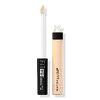What's inside
What's inside
 Key Ingredients
Key Ingredients

 Benefits
Benefits

 Concerns
Concerns

 Ingredients Side-by-side
Ingredients Side-by-side

Water
Skin ConditioningDimethicone
EmollientPropylene Glycol
HumectantButylene Glycol
HumectantPropylene Glycol Dicaprylate/Dicaprate
EmollientTrimethylsiloxysilicate
EmollientPolyglyceryl-4 Diisostearate/Polyhydroxystearate/Sebacate
EmulsifyingEthylhexyl Hydroxystearate
EmollientCetyl PEG/PPG-10/1 Dimethicone
EmulsifyingCaprylic/Capric Triglyceride
MaskingPEG-10
HumectantDisteardimonium Hectorite
StabilisingSodium Chloride
MaskingPhenoxyethanol
PreservativeAcrylates/Polytrimethylsiloxymethacrylate Copolymer
Skin ConditioningPolyhydroxystearic Acid
EmulsifyingTriethoxysilylethyl Polydimethylsiloxyethyl Dimethicone
Skin ConditioningIsopropyl Titanium Triisostearate
EmollientDimethicone/Vinyl Dimethicone Crosspolymer
Skin ConditioningTrihydroxystearin
Skin ConditioningSilica
AbrasiveEthylhexylglycerin
Skin ConditioningCaprylyl Glycol
EmollientDisodium EDTA
Sodium Hyaluronate
HumectantRosa Damascena Flower Water
MaskingCI 77891
Cosmetic ColorantCI 77492
Cosmetic ColorantCI 15850
Cosmetic ColorantCI 77491
Cosmetic ColorantCI 77499
Cosmetic ColorantWater, Dimethicone, Propylene Glycol, Butylene Glycol, Propylene Glycol Dicaprylate/Dicaprate, Trimethylsiloxysilicate, Polyglyceryl-4 Diisostearate/Polyhydroxystearate/Sebacate, Ethylhexyl Hydroxystearate, Cetyl PEG/PPG-10/1 Dimethicone, Caprylic/Capric Triglyceride, PEG-10, Disteardimonium Hectorite, Sodium Chloride, Phenoxyethanol, Acrylates/Polytrimethylsiloxymethacrylate Copolymer, Polyhydroxystearic Acid, Triethoxysilylethyl Polydimethylsiloxyethyl Dimethicone, Isopropyl Titanium Triisostearate, Dimethicone/Vinyl Dimethicone Crosspolymer, Trihydroxystearin, Silica, Ethylhexylglycerin, Caprylyl Glycol, Disodium EDTA, Sodium Hyaluronate, Rosa Damascena Flower Water, CI 77891, CI 77492, CI 15850, CI 77491, CI 77499
Water
Skin ConditioningCyclopentasiloxane
EmollientHydrogenated Polyisobutene
EmollientGlycerin
HumectantSorbitan Isostearate
EmulsifyingPropylene Glycol
HumectantTitanium Dioxide
Cosmetic ColorantOzokerite
Emulsion StabilisingPhenoxyethanol
PreservativeMagnesium Sulfate
Disteardimonium Hectorite
StabilisingDisodium Stearoyl Glutamate
CleansingMethylparaben
PreservativeAcrylates Crosspolymer
AbsorbentAlumina
AbrasiveButylparaben
MaskingAluminum Hydroxide
EmollientTocopherol
AntioxidantSilica
AbrasiveChamomilla Recutita Extract
Skin ConditioningCI 77891
Cosmetic ColorantIron Oxides
Mica
Cosmetic ColorantWater, Cyclopentasiloxane, Hydrogenated Polyisobutene, Glycerin, Sorbitan Isostearate, Propylene Glycol, Titanium Dioxide, Ozokerite, Phenoxyethanol, Magnesium Sulfate, Disteardimonium Hectorite, Disodium Stearoyl Glutamate, Methylparaben, Acrylates Crosspolymer, Alumina, Butylparaben, Aluminum Hydroxide, Tocopherol, Silica, Chamomilla Recutita Extract, CI 77891, Iron Oxides, Mica
 Reviews
Reviews

Ingredients Explained
These ingredients are found in both products.
Ingredients higher up in an ingredient list are typically present in a larger amount.
Ci 77891 is a white pigment from Titanium dioxide. It is naturally found in minerals such as rutile and ilmenite.
It's main function is to add a white color to cosmetics. It can also be mixed with other colors to create different shades.
Ci 77891 is commonly found in sunscreens due to its ability to block UV rays.
Learn more about CI 77891Disteardimonium Hectorite comes from the clay mineral named hectorite. It is used to add thickness to a product.
It can also help stabilize a product by helping to disperse other ingredients.
Hectorite is a rare, white clay mineral.
Learn more about Disteardimonium HectoritePhenoxyethanol is a preservative that has germicide, antimicrobial, and aromatic properties. Studies show that phenoxyethanol can prevent microbial growth. By itself, it has a scent that is similar to that of a rose.
It's often used in formulations along with Caprylyl Glycol to preserve the shelf life of products.
Propylene Glycol is an odorless, colorless liquid. As a humectant, it helps skin retain moisture. It also aids in delivering active ingredients.
Another role of this ingredient is preventing a product from melting or freezing. Propylene glycol also adds antimicrobrial properties to a product, elongating product lifespan.
This ingredient is considered an organic alcohol and commonly added into both cosmetics and foods.
Those with sensitive skin or conditions may develop a rash when using this ingredient.
Learn more about Propylene GlycolSilica, also known as silicon dioxide, is a naturally occurring mineral. It is used as a fine, spherical, and porous powder in cosmetics.
Though it has exfoliant properties, the function of silica varies depending on the product.
The unique structure of silica enhances the spreadability and adds smoothness, making it a great texture enhancer.
It is also used as an active carrier, emulsifier, and mattifier due to its ability to absorb excess oil.
In some products, tiny microneedles called spicules are made from silica or hydrolyzed sponge. When you rub them in, they lightly polish away dead skin layers and enhance the penetration of active ingredients.
Learn more about SilicaWater. It's the most common cosmetic ingredient of all. You'll usually see it at the top of ingredient lists, meaning that it makes up the largest part of the product.
So why is it so popular? Water most often acts as a solvent - this means that it helps dissolve other ingredients into the formulation.
You'll also recognize water as that liquid we all need to stay alive. If you see this, drink a glass of water. Stay hydrated!
Learn more about Water